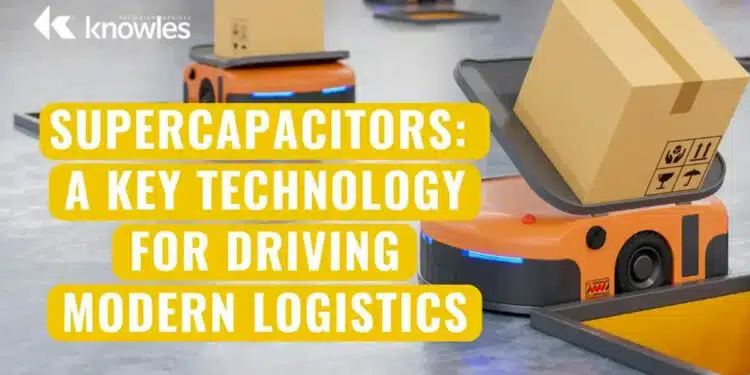This article based on Knowles Precision Devices blog explains role of supercapacitors in automated guided vehicles (AGVs), automated mobile robotics (AMRs) and other modern logistic devices.
As consumers demand rapid, and accurate, delivery of online orders, yet labor shortages continue to prevail, distributors need to increase efficiency and productivity, reduce errors, and improve inventory management in their warehouses.
To do this, distributors must modernize warehouse logistics by creating smart warehouses that incorporate technologies such as automated guided vehicles (AGVs), automated mobile robotics (AMRs), IIoT sensors, drones, and/or robotic arms. Using these technologies, distributors can streamline operations by automating and accelerating tasks such as order picking, inventory replenishment, automated storage and retrieval, and goods transportation.
Understanding the Key Functionality and Benefits of AGVs and AMRs
So, what exactly are AGVs and AMRs and what functions can these robotic devices serve in a warehouse? While AGVs and AMRs are both types of robotic systems, they have distinct differences in terms of technology, functionality, and applications within the warehouse.
This is largely because the navigation and guidance, and as a result, autonomy, of these two robotic systems is quite different. AGVs operate on pre-programmed routes using fixed guidance systems and have limited decision making capabilities, therefore requiring some human intervention. AMRs use cameras and advanced navigation systems such as LIDAR to plan in real time and adapt to environmental changes to independently optimize routes without human intervention.
As a result, AGVs are typically used for tasks such as transporting raw materials, pallet handling, and point-to-point transportation of goods – tasks that manual forklifts, conveyors, towing machines, and carts typically conduct. Since AMRs are more flexible, these robotic systems can be used for moving, picking, and sorting tasks, as well as goods-to-person systems.
Modernizing logistics with this type of robotic technology compared to a more traditional automated storage and retrieval system (AS/RS) offers several advantages. First, AGVs and AMRs offer greater flexibility, scalability and versatility. Second, AGVs and AMRs can be incorporated into an existing warehouse quite easily without modification to the floor plan or infrastructure as opposed to an AS/RS which requires installation of extensive infrastructure.
Keeping AGVs and AMRs Running with Supercapacitors
Like many mobile devices, AGVs and AMRs need some form of wireless power to function. While a battery may be the obvious answer, the frequent bursts of high power required for these devices to lift or dump objects, as well as the continuous energy needed to travel throughout a facility, can quickly drain battery life. This is problematic because batteries take a long time to charge, causing lengthy downtime while robots are offline being charged. To keep the facility running, more AGVs and AMRs are needed, leading to increased costs.
One way to avoid these issues is to use supercapacitors either in place of or alongside batteries in AMRs and AGVs. Powering AGVs and AMRs with supercapacitors instead of solely using battery power offers the follow benefits:
- Storage of as much as 100 times more energy per unit volume versus an electrolytic capacitor
- Charging and discharging much more quickly than batteries – often within seconds
- The ability to endure many more charging and discharging cycles versus conventional rechargeable batteries
Therefore, supercapacitors can provide peak power, and because they charge quickly, an AGV or AMR can operate without interruption—reducing downtime and increasing operational efficiency. Using supercapacitors can also extend the overall range of a devices’ energy storage system, releasing manufacturers from the time and expense of performing regular battery replacements. Additionally, because supercapacitors can charge within seconds, they are an excellent option to pair with in-floor inductive charging, keeping AGVs in service longer.
































